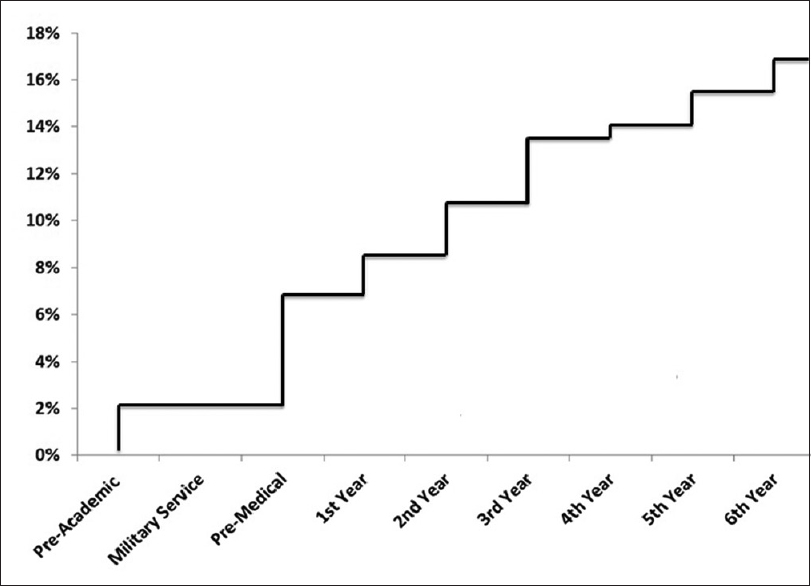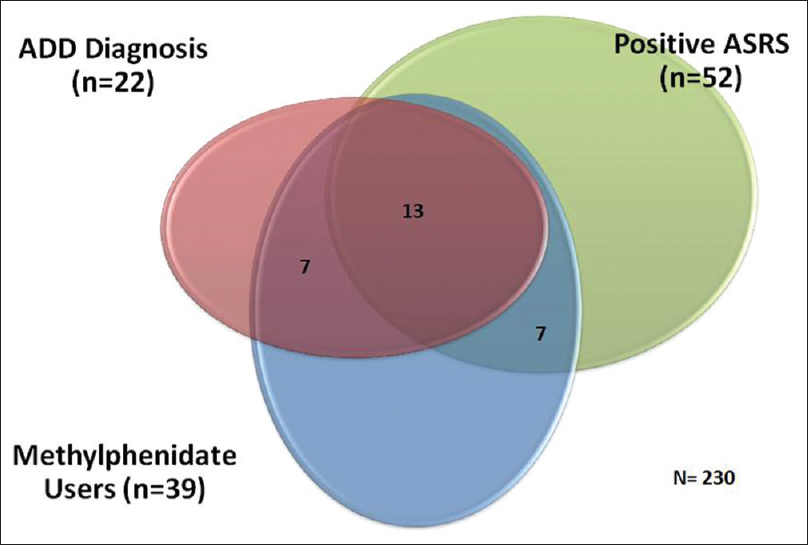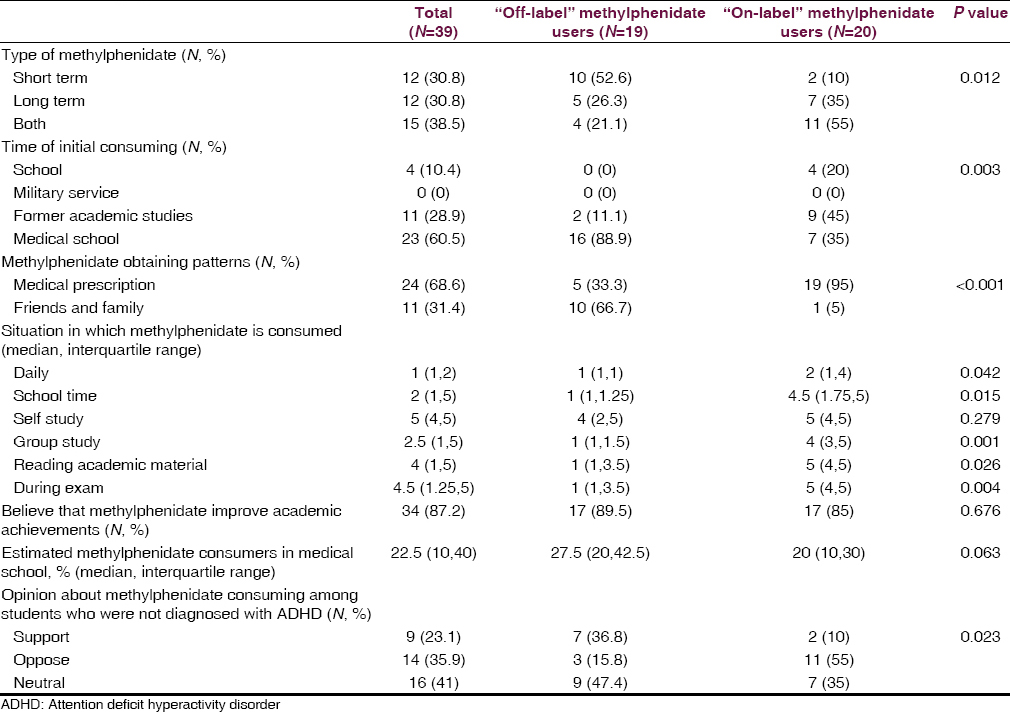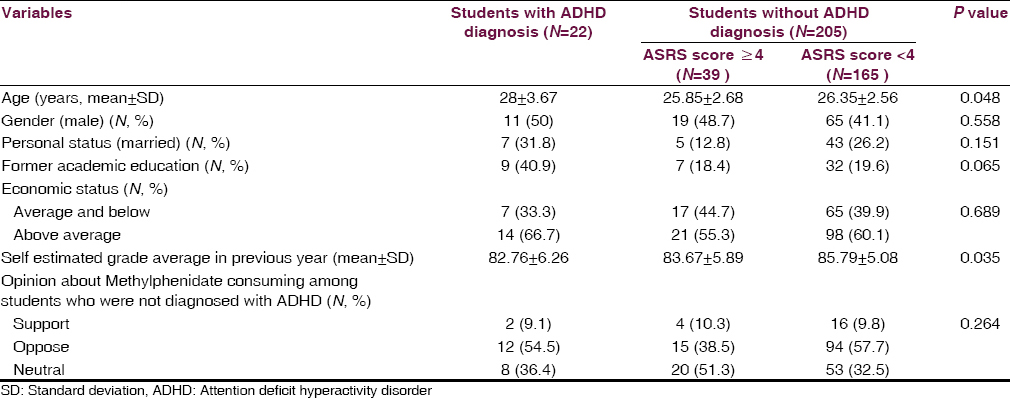Translate this page into:
Methylphenidate use among medical students at Ben-Gurion University of the Negev
Address for correspondence: Ms. Yael Givon Cohen, Department of Neurology, Soroka Medical Center, Beer Sheva - 844 3813, Israel. E-mail: yaelgiv@post.bgu.ac.il
This is an open-access article distributed under the terms of the Creative Commons Attribution-Noncommercial-Share Alike 3.0 Unported, which permits unrestricted use, distribution, and reproduction in any medium, provided the original work is properly cited.
This article was originally published by Medknow Publications & Media Pvt Ltd and was migrated to Scientific Scholar after the change of Publisher.
Abstract
Introduction:
Methylphenidate is a psychotropic agent commonly used for the treatment of attention deficit disorder with or without hyperactivity and narcolepsy in children and adults. The awareness to attention deficit disorder as well as the non-medical use of methylphenidate for cognitive enhancement has increased during the past years.
Objectives:
To evaluate the medical and non-medical use of methylphenidate among medical students in the Ben-Gurion University of the Negev.
Materials and Methods:
Medical students were asked to report methylphenidate use, symptoms and diagnosis of attention deficit disorder using a structured questionnaire.
Results:
A total of 229 students participated in the study, out of which 105 (45.9%) were in the pre-clinical years of medical school. Twenty-two students (9.6%) were previously diagnosed with attention deficit disorder. Lifelong use of methylphenidate was reported by 39 (17%) students, while 31 students (13.5%) reported using methylphenidate during the preceding 12 month. In the beginning of medical school, only 7% of the students used methylphenidate, most of them began using it during pre-clinical academic years.
Discussion:
High rates of attention deficit disorder compared to the general population were reported by medical students. The rate of methylphenidate use is similar to recent report from a US medical school, and is considerably higher than in college students population.
Conclusions:
Many medical students are using methylphenidate without a medical indication. Further study is needed to evaluate the effect of methylphenidate on academic performance of healthy adults.
Keywords
Adult ADHD self-report scale
attention deficit disorder
cognitive enhancement
medical students
methylphenidate
Introduction
Methylphenidate (MPH) is a mild CNS stimulant that acts on the brain stem arousal system and cortex. Short- and long-acting formulations of MPH are FDA approved for use in the treatment of attention deficit hyperactivity disorder (ADHD) and narcolepsy.[1] In Israel, it is the most common drug for treatment of ADD/ADHD sold under the brand names Ritalin®, Ritalin-SR®, Ritalin-LA® and Concerta®.
Lately there has been a significant increase in awareness of ADD/HD in adults. At the same time, a significant increase in the diagnosis of the disorder in adults has resulted in higher rates of MPH treatment. The number of MPH prescriptions issued in Israel for patients above 18 has increased over four folds between the years 2008 and 2012.[2]
At the same time, it seems that the adult “off-label” use of MPH is also on the rise mainly due to the perceived cognitive improvement.[3] Yet, its affect on healthy individuals is not clear, and its ability to bring improvement in cognitive functions was never proved. Both of these trends are particularly evident among academics, where many students attempt to obtain ADD/HD diagnosis, while others simply obtaining MPH prescription for “off–label” use.
Studies estimated the prevalence of MPH off-label use in about 1.5-8% of students.[45] Even a higher rate of the use was shown among medical student and dental students in the USA where up to 20% reported taking a stimulant medication.[6789] There is a sense, therefore, that the use of a cognitive enhancer in this population might be higher than in the general student population.
In this study we tried to evaluate the use of MPH among medical students in Ben Gurion University (BGU) in the Negev and evaluate the association between MPH use and self-report of ADD symptoms.
Materials and Methods
Survey
An anonymous, self-administered paper-and-pen questionnaire, consisting of 20 multiple-choice questions, was administered to students attending the Joyce and Irving Goldman Medical School (6-year course) at BGU during May–June 2013. Approximately 300 student study pre-clinical courses, while 250 students are in their clinical years (6-year curriculum). Overall, approximately 550 students study medicine at school in a given year. The questionnaires were distributed to the students between lectures and following exams. The study questionnaires did not include any identifying details, were completed by the students without the presence of an interviewer and were returned by the participants in a sealed envelope, which was opened only at the end of the study to ensure full anonymity of the data. The study was approved by the local institutional review board.
Evaluation tools
The study questionnaire comprised the following:
ADHD Adult Self-Report Scale Screener
The ASRS-S was used to assess the presence of ADD/ADHD among the students studied. The ASRS-S[10] is a six-item screening tool derived from the 18-item ASRS which itself is derived from the 18 symptoms that are included in the Diagnostic and Statistical Manual of Mental Disorders version 4 (DSM-IV)[11] for diagnosing ADD/ADHD. The following six of the 18 items were found to be most predictive for the disorder and thus are used as a screening tool:
-
How often do you have trouble wrapping up the final details of a project,once the challenging parts have been done?
-
How often do you have difficulty getting things in order when you have to do a task that requires organization?
-
How often do you have problems remembering appointments or obligations?
-
When you have a task that requires a lot of thought, how often do you avoid or delay getting started?
-
How often do you fidget or squirm with your hands or feet when you have to sit down for a long time?
-
How often do you feel overly active and compelled to do things, like you were driven by a motor?
Subjects had to rank those statements on a scale of 1 to 5 where 1 = never, 2 = rarely, 3 = sometimes. 4-often, 5 = very often. A positive respone was considered rank sometimes- very oftern on statements 1-3 and often-very often on statements 4-6.
We used a Hebrew version of the ASRS-S, which was previously validated.[12] Four positive statements are considered as a positive ASRS result (ASRS score 4 or above).
ADD/ADHD and MPH use
The participants were asked to report whether they had ever been diagnosed by a physician as having ADD and, if so, when. They were also asked to report whether they had ever used MPH (long- or short-acting MPH preparation) or any other stimulant, if so, when did they started using it and whether they had used it within the last 12 months.
MPH use patterns
Students reporting MPH use were asked to assess medicaition influence on their self-perceived academic performance and to report for which tasks they used MPH.
Attitudes and beliefs
The last part of the survey addressed the students’ perceptions regarding stimulant use. Students were asked to assess what proportion of their classmates use MPH, whether they believe that stimulants may improve academic performance, and, if so, what is their attitude toward “off-label” use of cognitive enhancers.
Statistical analysis
Statistical analysis was done using SPSS version 18. The results are presented as the mean (SD) for continuous variables and for the total subjects (the percentage of total subjects) for categorical data. The T-test was used for comparing continuous variables and the Chi-square test was used for categorical data, augmented by Fisher's exact test, if needed. We used the Mann–Whitney test for the comparison of variables not distributed normally and were presented as median and interquartile range (IQ range). Cumulative incidence of MPH use before academic studies and throughout medical school was calculated and is presented in Figure 1. A Venn diagram [Figure 2] was created in order to demonstrate the relation among positive ASRS score, ADHD formal diagnosis and MPH use. The two-tailed P < 0.05 was considered significant.

- The distribution of onset times and the cumulative incidence of drug use in each phase of medical school

- The intersection of the three main diagnoses of the study's participants: Students diagnosed with ADD, students with positive ASRS test and students who consume methylphenidate regularly. Note that only 13 students were ASRS positive and diagnosed with ADD
Statistical biases
Being a questionnaire-based study, several common biases that might cause deviation in the results were considered while designing the questionnaire.
Biases can result from vague or complex phraseology, insufficient number of categories (forced choices) and leading questions. To overcome these biases, the questionnaire was first distributed to a reference group of students, and subsequently edited to remove any perceived vagueness. As for leading questions, the biases can result from framing, mind-set questions. All efforts were made to keep questions and answers neutral (not negatively or positively worded) and to ensure consistency (in order to avoid the affect of one's mindset perception of the questions). As for questionnaire design, the main biases are referred to juxtaposed scales, which force respondents to think and compare their views, yet may be confusing for some of the students and thus affect the validity of the response. Another important bias can arise from the questionnaire length and respondents fatigue. Therefore, we kept the length of the questionnaire to no more than 20 minutes to complete.
Results
The response rate was 96%, with 229 total responses from among the 260 students who received the questionnaire form. None of the questionnaires was disqualified. The respondents age was 26.42 ± 2.75 and 96 were males (43.2%). One hundred and five students were in their pre-clinical years (years 1–3), comprising 45.9% of the cohort, while the remaining 114 students were in their clinical studies (years 4–6). Out of the 229 students included in the analysis, 39 had taken MPH at least once, while 198 did not use MPH. Out of the MPH users, 31 had taken MPH during the year prior to the study and were considered active users, while 8 students had not used MPH during the 12 months prior the survey.
Cumulative incidence of MPH use throughout medical school is demonstrated in Figure 1, which shows the distribution of onset times of drug use at each phase of medical school. It is notable that the major increase in the use rate was prior to the medical school and during other academic studies (4% raise). In the first year, about 6% of the students use MPH, during medical school the rates climb gradually with a significant increase in the third year, from 10% to 14%. By the end of the sixth year we can see a usage rate of 18%.
A Venn diagram presented in Figure 2 shows the intersection of the three main groups among the study's participants: Students diagnosed with ADD; students with positive ASRS test; and students who use MPH regularly. Twenty-two students had formal ADD diagnosis and 52 students had positive ASRS-S score, yet only 13 students were ASRS positive and diagnosed with ADD. The 39 users are presented in the circle below with 20 of them diagnosed with ADD (out of which 13 also had positive ASRS-S score) and 7 more had a positive ASRS-S score but no formal ADD diagnosis.
Baseline characteristics of those who used MPH during the last 12 months are depicted in Table 1. Active MPH users were older, compared with non-active ones (28.13 ± 3.45 vs. 26.14 ± 2.52 respectively, P = 0.001) and self-estimated their grades in the previous year lower than those who did not use MPH (81.31 ± 5.93 vs. 85.72 ± 5.08, respectively, P < 0.001). More students who used MPH during the last 12 months had previous higher education experience prior to commencing medical school studies (45.2% vs. 17.4%, P < 0.001).

Overall, 39 students (17% of our total cohort) had used it at least one time. Among them, 20 (51.3%) had taken MPH according to prescription (“on label”) while 19 (48.7%) had taken the drug without prescription (“off label”). Majority of “off-label” users had taken short-term MPH (52.6%), while most of the “on-label” users had taken both kinds of MPH, namely long and short acting (55%). While 88.9% of “off-label” users had begun to use the drug during their medical school studies, a majority of “on-label” users had started to take MPH during their former academic studies (45%), P = 0.003. When asked regarding their opinion of MPH use among students who had not been diagnosed with ADHD, most of the “off-label” users were indifferent (47.4%), while 55% of “on-label” users opposed drug use among undiagnosed students (P = 0.023) [Table 2].

In our cohort, 22 (9.6%) students have a formal diagnosis of ADHD made by a physician. Among the 205 students without formal diagnosis, 39 (19%) had the positive ASRS test (ASRS score four or above). As demonstrated in Table 3, students with a formal diagnosis were by 2 years. older compared with those without the diagnosis Students with ASRS score lower than four self-estimated their academic grades higher (85.79 ± 5.08) than those with ADHD diagnosis (82.76 ± 6.26) and those with ASRS score 4 and above (83.67 ± 5.89), P = 0.035.

Discussion
In this study we attempted to evaluate the prevalence of MPH use among medical students and its relationship to the established and possible ADD/HD diagnosis. Among the study participants, 9.6% reported having a formal ADD/HD diagnosis. ASRS-S questionnaire was positive (four positive answers and above) in 22.7%.
Among the participating students, 13.5% reported using MPH in the past 12 months prior to the study, while 17% reported lifetime use. This is similar to the rate reported[9] among US medical students (20% prevalence of life time use, 15% during medical school), and higher than prevalence reported[8] a few years ago (10.1%) in the USA and the rate among American college students (6.9%). These figures are significantly higher than the reported worldwide prevalence of ADD/HD among adults. Two meta-analyses found the prevalence of AD/HD to be 2.5-4.4%,[1314] and the rate of adults with positive ASRS-S is 8.2% in wide survey conducted in Britain in 2007.[15] Alongside with that, the findings among Israeli students are similar to those recently reported among US medical students, where a 5.5-9% prevalence was reported. It is hard to determine whether the high prevalence of ADD/HD found among medical students indeed represents a higher prevalence of the disorder or reflects higher self awareness to symptoms and greater diagnostic availability.
The effectiveness of MPH as enhancing therapy to improve cognitive abilities in general and academic performance in particular, is still controversial. Several studies examined the effect of MPH on the cognitive function of healthy youth and adults. These studies showed MPH appears to improve performance in novel tasks and attention-based tasks and reduces planning latency in more complex tasks.[16] MPH was not found to be helpful in visual learning and memory.[17] Despite this, it was never demonstrated that MPH improves academic performance. Healthy youth treated with placebo in studies examining the efficacy of MPH, reported improvement in “intellectual energies” and higher efficiency in carrying out tasks, although participants didn’t differ in their performance from the control group of those not taking MPH.[18] It is possible that the expectation effect to functional improvement is able to explain the vast use of the medication.
The ethical perspective of “enhancing medicine” was discussed thoroughly in the medical and popular media and also by the ethical chamber of the Israeli medical association. The consensus is that enhancing medicine is allowed under medical restrictions and close observation following the establishment of the treatment efficacy. The students treated with MPH “off-label” introduce a different situation: Future doctors using supervised medication without prescription or follow-up, based on self diagnosis, without assessment of side effects or treatment efficacy.
The wide use of MPH among medical students is probably related to the competitive environment encouraging and even demanding higher grades. The need to improve their academic abilities leads students to seek enhancing medical treatment. However, many of these students present symptoms of ADD/HD, and it is possible that these students can gain benefit from controlled medical treatment. A proactive diagnostic plan of AD/HD among medical students can identify the students who may benefit from treatment in one hand, and prevent uncontrolled and inefficient use of the drug on the other hand. Moreover, lack of the proven cognitive efficacy benefit associated with MPH makes its “off-label” use by anybody and particularly by future medical doctors highly questionable.
Our study, demonstrating a high prevalence of MPH use among medical students for both medical indication and “off-label” use, has several limitations: It is based on self report and therefore may under represent non-medical use of the drug. The study was conducted in a single institution, making its generalisability limited.
Conclusion
The rate of use of MPH among the medical students in our study is similar to the rate recently reported among US medical students. The prevalence of ADD/HD is higher among students than the estimated prevalence in adults. Proactive diagnosis for ADD/HD and insisting on “on-label” MPH use may help those who may benefit from such a treatment and prevent uncontrolled use. It is necessary to conduct further research about the possible effects of MPH on academic performances of healthy individuals.
Source of Support: Nil.
Conflict of Interest: None declared.
References
- Methylphenidate: A review of its neuropharmacological, neuropsychological and adverse clinical effects. Hum Psychopharmacol (2004). ;19:151-180.
- [Google Scholar]
- CBS 60 Minutes. Boosting Brain Power (2010) (Accessed on 26/5/2014) http://www.cbsnews.com/video/watch/?id = 6430949n and tag = api
- [Google Scholar]
- What should we do about student use of cognitive enhancers? An analysis of current evidence. Neuropharmacology. 2013;64:588-95.
- [Google Scholar]
- Non-medical use of prescription stimulants among US college students: Prevalence and correlates from a national survey. Addiction, 100 (1): 96-106. Erratum in Addiction. 2005;100(4):573.
- [Google Scholar]
- Prevalence of ADHD diagnosis and nonmedical prescription stimulant use in medical students. Academic Psychiatry. 2010;34(3):220-3.
- [Google Scholar]
- The Nonmedical use of prescription stimulants among dental and dental hygiene students. Journal of Dental Education,. 2011;75(3):365-76.
- [Google Scholar]
- Cognitive enhancement in Canadian medical students. J Psychoactive Drugs. 2013;45(4):360-5.
- [Google Scholar]
- Prevalence of stimulant use in a sample of US medical students. Ann Clin Psychiatry. 2013;25(1):27-32.
- [Google Scholar]
- The world health organization Adult ADHD Self-Report Scale (ASRS): A short screening scale for use in the general population. Psychological Medicine. 2005;35:245-256.
- [Google Scholar]
- American Psychiatric Association: Diagnostic and Statistical Manual of Mental Disorders, Fourth Edition, Text Revision. Washington, DC: American Psychiatric Association; 2000. p. :85-93.
- [Google Scholar]
- Diagnosing ADHD in Israeli adults: The psychometric properties of the adult ADHD Self Report Scale (ASRS) in Hebrew. Isr J Psychiatry Relat Sci. 2010;47(4):308-15.
- [Google Scholar]
- Prevalence and correlates of adult attention-deficit hyperactivity disorder: Meta-analysis. Br J Psychiatry. 2009;194(3):204-11.
- [Google Scholar]
- The prevalence and correlates of adult ADHD in the United States: Results from the National Comorbidity Survey Replication. Am J Psychiatry. 2006;163:716-723.
- [Google Scholar]
- National Centre for Social Research and Department of Health Sciences, University of Leicester. Adult psychiatric morbidity in England, 2007: Results of a household survey. 2008. London: Health and Social Care Information Centre; http://www.esds.ac.uk/doc/6379/mrdoc/pdf/6379research_report.pdf
- [Google Scholar]
- Efficacy of stimulants for cognitive enhancement in non-attention deficit hyperactivity disorder youth: Asystematic review. Addiction. 2014;109(4):547-57.
- [Google Scholar]
- Cognitive effects of methylphenidate in healthy volunteers: A review of single dose studies. Int J Neuropsychopharmacol. 2014;17(6):961-77.
- [Google Scholar]
- Expectation to receive methylphenidate enhances subjective arousal but not cognitive performance. Exp Clin Psychopharmacol (19):433-44.
- [Google Scholar]






